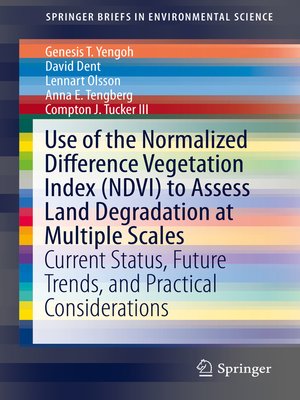Use of the Normalized Difference Vegetation Index (NDVI) to Assess Land Degradation at Multiple Scales
ebook ∣ Current Status, Future Trends, and Practical Considerations · SpringerBriefs in Environmental Science
By Genesis T. Yengoh

Sign up to save your library
With an OverDrive account, you can save your favorite libraries for at-a-glance information about availability. Find out more about OverDrive accounts.
Find this title in Libby, the library reading app by OverDrive.



Search for a digital library with this title
Title found at these libraries:
| Library Name | Distance |
|---|---|
| Loading... |
This report examines the scientific basis for the use of remotely sensed data, particularly Normalized Difference Vegetation Index (NDVI), primarily for the assessment of land degradation at different scales and for a range of applications, including resilience of agro-ecosystems. Evidence is drawn from a wide range of investigations, primarily from the scientific peer-reviewed literature but also non-journal sources. The literature review has been corroborated by interviews with leading specialists in the field.
The report reviews the use of NDVI for a range of themes related to land degradation, including land cover change, drought monitoring and early warning systems, desertification processes, greening trends, soil erosion and salinization, vegetation burning and recovery after fire, biodiversity loss, and soil carbon. This SpringerBrief also discusses the limits of the use of NDVI for land degradation assessment and potential for future directions of use.
A substantial body of peer-reviewed research lends unequivocal support for the use of coarse-resolution time series of NDVI data for studying vegetation dynamics at global, continental and sub-continental levels. There is compelling evidence that these data are highly correlated with biophysically meaningful vegetation characteristics such as photosynthetic capacity and primary production that are closely related to land degradation and to agroecosystem resilience.
The report reviews the use of NDVI for a range of themes related to land degradation, including land cover change, drought monitoring and early warning systems, desertification processes, greening trends, soil erosion and salinization, vegetation burning and recovery after fire, biodiversity loss, and soil carbon. This SpringerBrief also discusses the limits of the use of NDVI for land degradation assessment and potential for future directions of use.
A substantial body of peer-reviewed research lends unequivocal support for the use of coarse-resolution time series of NDVI data for studying vegetation dynamics at global, continental and sub-continental levels. There is compelling evidence that these data are highly correlated with biophysically meaningful vegetation characteristics such as photosynthetic capacity and primary production that are closely related to land degradation and to agroecosystem resilience.







